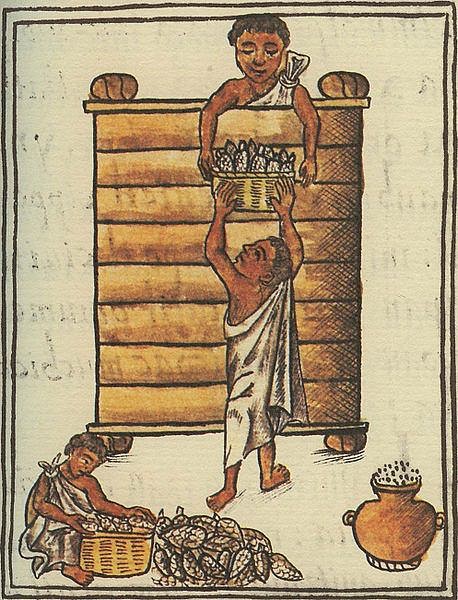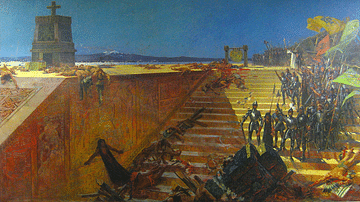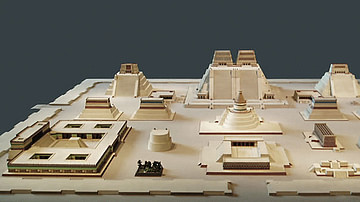Aztec society was hierarchical and divided into clearly defined classes. The nobility dominated the key positions in the military, state administration, judiciary, and priesthood. While traders could become extremely wealthy and powerful, even their prosperity was based on their class, and most citizens remained simple farmers.
Within Aztec society, there was a limited opportunity for individuals to better their social position, especially in the military and religious spheres. It is also true that nepotism prevailed but, at the same time, promotions could be obtained on merit as well as demotions from incompetence. In practice, though, the vast majority of the Aztec population would have remained in the social group of their immediate family throughout their lives.
The Calpolli
The most important social grouping in Aztec society was the calpolli, which was a collection of families connected either by blood or long association. Elders, led by the calpolec (a chief elected for life), controlled the landholdings of the calpolli distributing it for members to farm as their own on the condition that they paid a regular tribute in return. Another condition of these common farmers or macehualtin (also macehuales) was that they not leave their land untended for more than two years. If a farmer died without children, his land was returned to the elders for redistribution. The calpolli also had their own temple, and so the group performed religious rituals and festivals together. The Aztec capital Tenochtitlan had 80 calpoltin, but the system existed across the empire.
Farmers
Farmers, or macehualtin, were by far the largest section of Aztec society and they were divided into two further groups. First, and lower in status, were the field workers who did the donkey work of hoeing, weeding, planting, irrigating etc. The higher group was more supervisory in role and consisted of specialised horticulturalists who were responsible for seeding and transplanting. They also understood such matters as crop rotation and the best times for planting. Aztec farmers may be further divided into those who worked their own land and those who worked the land of large estates and paid their rent with whatever they farmed. These serfs were the lowest class of all in Aztec society, known as mayeque; they owned no land and paid up to 30% of their produce to their overlords. In addition to farming, the macehualtin were also expected to perform military service in times of war and assist in state projects such as road and temple building.
Slaves
Aztec society also contained slaves or tlacohtin ('bought ones') who were conquered peoples, those guilty of serious crimes such as theft, or individuals who had got themselves into so much debt (most often through gambling) that they were forced to sell themselves as a commodity for a certain period or even for life. If they had the means, slaves could also buy themselves free again. Slaves could be required not only to farm but also to work as general labourers, domestic servants, or concubines. Slaves were generally not re-sold and were protected by law from any abuse from their masters or anyone else. Talented slaves could gain important positions such as estate managers and were free to marry non-slaves, with any children from such a marriage being born free as slavery status was not inherited.
Artisans & Traders
The artisan class were known as tolteca after the earlier Toltec civilization, which the Aztecs revered, and so craftsmen were held in high regard. They often worked in specialised large-scale workshops, and they included carpenters, potters, stonemasons, metal workers, weavers, feather workers, and scribes. Other important professions were the merchants, traders, and professional hunters. The most prestigious traders were those who conducted their business over extensive territories and were known as pochteca, a hereditary position. They often traded for the state and specialised in such precious goods as tropical bird feathers, gold, turquoise, shells, greenstone, cacao beans, and exotic animal skins. The pochteca were supervised by the pochtecatlatoque, the most experienced traders, who administered trade and justice amongst the trading class in special courts. One specialised group of traders was the tlaltlani, who traded in slaves. As they had the important role of providing the state with sacrificial victims, they were given special privileges and gained great wealth.
Two other groups of traders were the tencunenenque, who acted as tribute collectors, and the naualoztomeca, who disguised themselves and traded in hostile territory, acting as spies for the state as they picked up loose gossip in foreign markets. Traders were also involved in the state religion, especially the festival of tonalpohualli dedicated to Huitzilopochtli, the god of war, where they funded celebratory banquets and provided slaves for sacrifice.
Nobles
The nobility or pipiltin (sing. pilli) were easily identified by their appearance as they exclusively wore prized feather garments. Owners of private land, they were wealthy thanks to tribute from their tenants and serfs. State administrators were selected from the pipiltin class, although commoners might enter this hereditary class by performing deeds of great valour on the battlefield. These social risers were known as cuauhpipiltin or 'eagle nobles'.
One level above the pipiltin was the teteuhctin, who held the highest positions in the state apparatus such as city and regional governors. Living in large palaces, they wore even more splendid clothes and jewellery, and they had the prestigious -tzin suffix added to their names. The Aztec king, the tlatoani, was a member of this class.
Priests
The priestly class not only orchestrated the state religion and its many festivals and rituals but also ran the state education system and, to a significant degree, controlled Aztec artistic output in all its forms. A male or female from any social class could become a priest, or tlamacazqui, but the most powerful ones always came from the pipiltin class. At the very top of the religious hierarchy was the king himself aided by two high-priests: Quetzalcoatl totec tlamacazqui, in charge of the Huitzilopochtli cult, and Quetzalcoatl tlaloc tlamacazqui, the head of the cult to the rain god Tlaloc. Other notable priestly positions included the supervisor of the elite state-run schools, the Mexicatl Teohuatzin; the general supervisors of the priesthood, festivals, and temple sites, the Huitznahua Teohuatzin and Tecpan Teohuatzin; and finally, the lowest level of priest were the quacuilli, who were in charge of a small district or parish.
Some priests also became experts in other, yet closely related areas such as astronomy and writing. Still others developed a talent for medicine, prophesy, and the interpretation of visions and dreams. The latter acquired the title tonalpouhque, and they gave advice on which days were auspicious for all manner of events from marriages to long journeys. Priests could also be warriors, and two important priestly functions in Aztec warfare were to carry into battle effigies of the major Aztec gods and to collect sacrificial victims from the bravest warriors amongst the vanquished. Finally, a separate but related group were the witchdoctors and magicians who performed strange ceremonies, claimed transformational gifts, and cast spells on the wicked.
Education
As in modern societies, Aztec education could determine one's future social position. Children of commoners went to school, which was compulsory, but only from their early teens. Before that, children were educated by their parents. That the priority of most males was to become a valuable warrior for the state is evidenced in the practice of all 10-year old boys being given a special haircut with a lock left long at the nape of the neck (a piochtli). Only when they had captured their first prisoner could they cut this lock.
The telpochcalli or 'youth house' for boys gave military training while the one for girls taught duties to be performed in religious ceremonies. Both sexes would also learn dancing, singing, public speaking and recital skills, and history, as well as take fundamental moral and religious lessons.
The calmecac school was reserved for children of the nobility who learnt essential skills for a public career in the military, politics, or the state religion. Again, the sexes were separated, and there is some evidence that exceptionally gifted children from the lower classes could also attend a calmecac. Subjects learnt included rhetoric, music, poetry, law, astronomy, mathematics, history, architecture, agriculture, and warfare. For those selected to enter into the priesthood, their education continued at a special institution called the tlamacazcalli. Here, students endured a severe education and life of austerity which included long periods of meditation, fasting, and sacrificing their own blood by piercing themselves in sensitive places with cactus spines.
Marriage
A young person's education ended when they were ready to be married. This was arranged by elders, although their selection was probably influenced by the young couple themselves who may have previously established a relationship at the many public festivals. Generally, partners came from the same calpolli. Aged in their late teens or early twenties, the couple would marry in a four-day ceremony when the bride would be decked in red feathers and covered in sparkling powder of 'Fool's Gold' pyrite. Much feasting and speech-making would complete the celebration.
Although women were expected to tend the home, cook, care for children, and practice weaving and basketwork, Aztec women also retained control of their personal property and inherited wealth, and could participate in public life in the fields of medicine, education, religion, and even commerce. Also unusual for ancient societies, Aztec men were expected to bear the responsibility of bringing up their male offspring. Nevertheless, the marriage arrangement favoured the male as the couple lived with his family, and he was also permitted to have several other wives and host a number of concubines.
Conclusion
For the Aztecs, with perhaps the exception of the trader class, wealth was not pursued for its own sake, but rather it was a benefit of one's position. Rank and reputation were by far the most important considerations for those who wished to rise in society and, above all, ownership of land continued to be the greatest indicator of a person's status. Aztec society was clearly stratified and had many levels, but the common bonds of perpetual warfare and an ever-present religion ensured a sophisticated and functional social apparatus was created which was both cohesive and inclusive. Whether this society, already evolving as the trading class became more influential in areas traditionally reserved for the aristocracy, could have developed and prospered had it not collapsed following the invasion from the Old World is one of history's great what if? questions.









